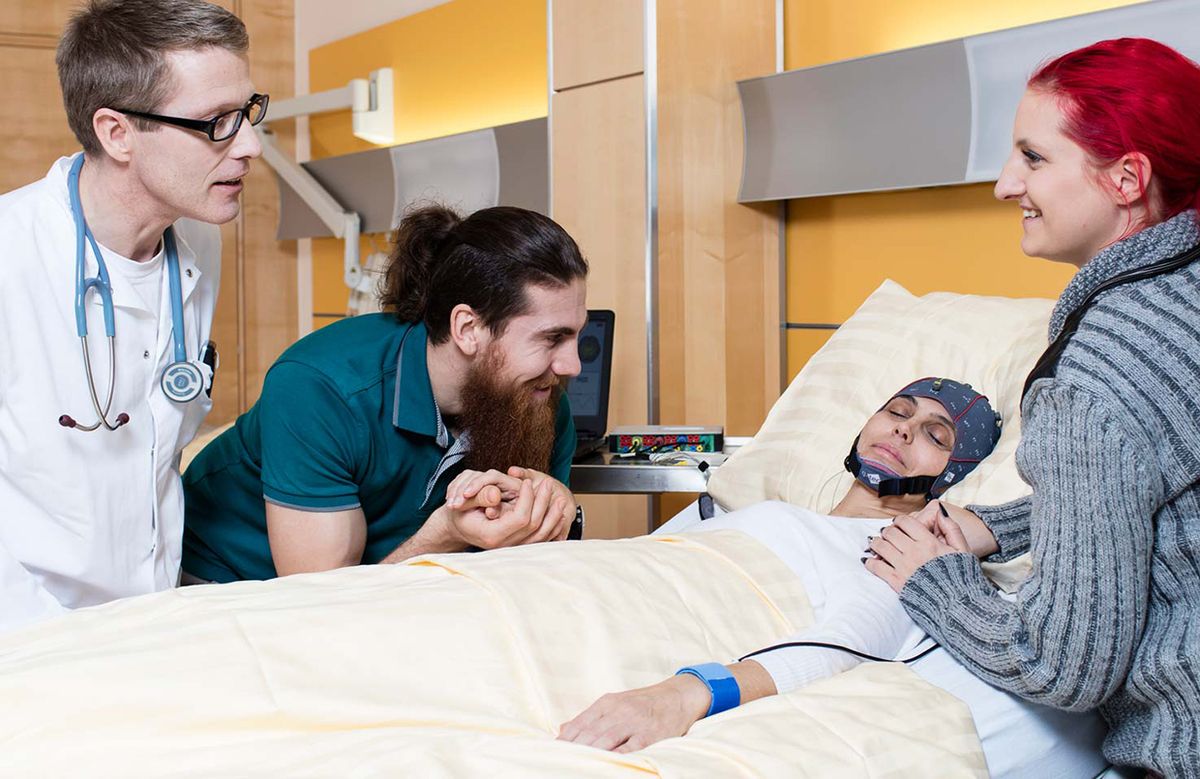An Austrian organization is using brain-computer interface technology to help people in one of life’s most horrifying plights: being cognitively aware, but trapped in a body that can’t move, speak, blink or communicate in any way. The developer of the system, g.tec medical engineering, is commercializing the system, and this week held an explanatory workshop at Society for Neuroscience’s meeting in Washington D.C.
The tool gives people in this dreaded condition, called locked-in syndrome, the ability to answer yes-or-no questions using only their thoughts. The technique can also aid communication with people in unresponsive wakefulness states, but not people in comas where there in no cognitive function.
The system, called mindBEAGLE, relies on electroencephalography (EEG) to detect brain activity, and machine-learning algorithms to interpret the meaning of that activity—a type of communication called brain-computer interface, or BCI. In the mindBEAGLE system, users wear on their scalps an EEG cap with 16 electrodes. They also wear on their hands vibration motors that deliver tactile sensations much like the vibration of a ringing mobile phone.
Then the user is asked a yes-or-no question. To respond, users focus on the vibrations on one of their hands—left hand for ‘yes’ and right hand for ‘no.’ The EEG cap detects the brain activity generated by the task. The most important signals are p300s—brain waves that occur when someone is responding to an uncommon event that requires attention, says Christoph Guger, CEO and founder of g.tec.
Algorithms trained by Guger and his team then identify the user’s p300 waves and their association with the right or left hand. The computer, accordingly, flashes the word ‘yes’ or the word ‘no’ to anxiously awaiting loved ones. Each question takes about 38 seconds.
In a study of patients with locked-in syndrome, 9 out of 12 people were able to communicate using the BCI system, answering on average eight out of ten questions correctly, according a study led by g.tec and the University of Palermo, in Italy. Additionally, two out of three patients with the most severe form of locked-in syndrome, called complete locked-in syndrome, could communicate using the system with about 80% accuracy.
People “locked-in” usually get to that state after traumatic brain injury, stroke, medication overdose or a neurodegenerative disease such as amyotrophic lateral sclerosis (ALS).
The latter is the case for Carmelina, a woman in Palermo, Italy, whose neurodegenerative disease has left her unable to move any part of her body or respond in any way in over three years. Carmelina’s daughter, in the video made by the University of Palermo below, says that she wasn’t sure if her mother could hear her. So she used the mindBEAGLE system, and found that her mother could indeed understand. Now Carmelina’s family visits her more often, they read books and have much more interaction with her, Guger says.
In addition to helping families, the technology could help patients make clear their will and consent for medical treatment, and help doctors make decisions. A physician who has objective proof of cognition might “pay more attention to the patient, or change strategies or medications,” Guger says.
Cognitive assessments are usually conducted shortly after a brain injury “and this dictates the rest of your life how you are treated,” says Guger. But that initial assessment could have occurred on a “bad day” when the patient was tired, he says. More frequent assessments that can be done quickly will help catch patients on a good day, or good time of day, revealing the true extent of their consciousness.
Researchers at the Neuroelectrical Imaging and BCI Laboratory at Fondazione Santa Lucia in Rome is developing a similar BCI system to decode the thoughts of people in vegetative or minimally conscious states. And the Wyss Center for Bio and Neuroengineering in Geneva have developed a BCI tool for locked-in patients using functional near-infrared spectroscopy (fNIRS).
Guger says g.tec’s system is the first such BCI system to be commercialized. Its protocols are easily repeatable, so the system can be deployed anywhere, including at the patient’s home, with help from a trained technician, he says. His company last month opened a new facility in Albany, New York at the University of Albany’s health science campus. The center’s staff will treat and rehabilitate people who have had a stroke, and make home visits to other patients with locked-in syndrome. The company has two additional such centers—one in Austria and another in Spain.
Emily Waltz is a features editor at Spectrum covering power and energy. Prior to joining the staff in January 2024, Emily spent 18 years as a freelance journalist covering biotechnology, primarily for the Nature research journals and Spectrum. Her work has also appeared in Scientific American, Discover, Outside, and the New York Times. Emily has a master's degree from Columbia University Graduate School of Journalism and an undergraduate degree from Vanderbilt University. With every word she writes, Emily strives to say something true and useful. She posts on Twitter/X @EmWaltz and her portfolio can be found on her website.



